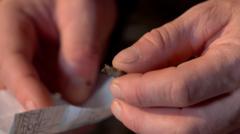Ukrainian serviceman Serhiy Melnyk carries a grim reminder of his frontline experience: a small rusted shard of metal that once lodged in his heart, a piece of shrapnel from a Russian drone. He recalls the moment, "I thought I was just short of breath under my body armour. They had to extract shrapnel out of my heart." As drone technology evolves, so do the injuries sustained by soldiers, with battlefield medics reporting that shrapnel wounds account for up to 80% of trauma cases in Ukraine.
Untreated, such an injury could turn fatal. Serhiy notes the severity of the fragment, which doctors described as "a large piece" that fortunately didn't take his life. His survival can be attributed to an innovative medical tool — a magnetic extractor.
Cardiovascular surgeon Serhiy Maksymenko illustrates how this tool works: a thin magnet-tipped device is inserted through a small incision, allowing surgeons to retrieve shards from within the heart. In the year since its introduction, over 70 successful operations utilizing this technology have been performed, transforming medical practices on the frontline.
The magnetic extractor was born out of necessity. Oleh Bykov, a volunteer supporting the Ukrainian military, recalls witnessing the direct impact of shrapnel injuries on soldiers and driving the advancement of this extraction technology. While magnets have been used medically since the 1800s, Bykov's team has adapted and modernized the application for current combat conditions, creating various models suitable for different types of injuries.
The result is a tool that minimizes invasiveness, increases precision, and reduces recovery time for wounded soldiers. "In war, things get developed which would never have been thought of in civilian life," says veteran war medic David Nott, emphasizing the innovation born out of conflict, particularly in managing fragmentation wounds.
Currently, the magnetic extractors have been distributed widely across Ukraine, equipping about 3,000 healthcare providers, including first responders like Andriy Alban, who operates in makeshift clinics under dire conditions, all while needing to act swiftly and effectively.
Despite the extractor's success, the device lacks formal certification. The Ukrainian Health Ministry has stated that in times of martial law or emergency, the use of unapproved medical devices is permissible. Oleh expresses his commitment to this lifesaving technology, accepting the possibility of repercussions for the sake of its impact on survival rates. Nott concurs, highlighting that in war, saving lives takes precedence over bureaucratic procedures.
In Lviv, Serhiy's wife Yulia expresses immense gratitude for the innovation that has spared her husband's life, stating, "Thanks to them, my husband is alive." As medical technology evolves in response to the unprecedented demands of modern warfare, the magnetic extractor showcases the potent blend of ingenuity and necessity.




















